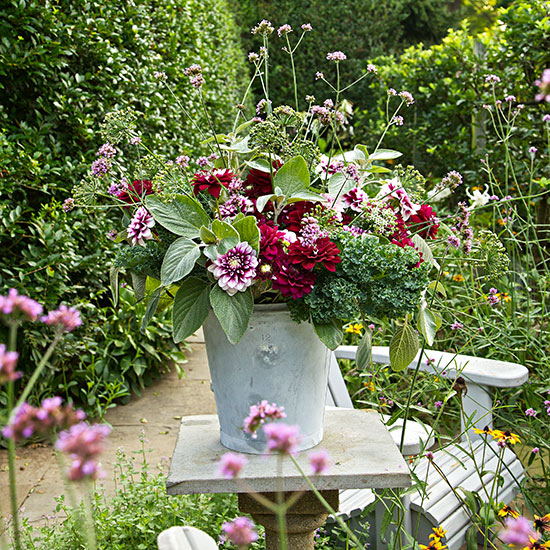






How do we love dahlia flowers? Let us count the ways!
Begin by planting dahlias in a spot that gets at least eight hours of direct sunlight a day. In dry, hot-summer climates, choose a spot that provides direct sun from the morning into midday, offering shade or filtered shade by the hottest part of the late afternoon.
Like potatoes, dahlias grow from tubers so good soil preparation is key to best performance. Loosen or dig soil to a depth of about 10 inches. Your soil should be easily worked and offer superb drainage. If you have heavy soil, amend with peat moss, compost, or aged cow manure.
Planting is a good time to incorporate an organic fertilizer with an N-P-K ratio of 5-10-15 or 5-10-10, 10-20-20, or 0-20-20. The higher middle number -- phosphorous -- assists with bloom production. The third number -- potash or potassium -- helps root development. Any fertilizer recommended for vegetables can be used for dahlias.
Although you can start dahlias from seeds, it's easiest to begin with tubers. After the soil is prepared, dig a hole 4-6 inches deep, lay the tuber horizontally, and cover with soil. If you're planting several dahlias, grow the smaller varieties 9-12 inches apart. Taller dahlias can be spaced 2-3 feet apart, or half their final height (some can grow taller than 6 feet, so be prepared!).
Except in hot climates, don't water the tubers until the first shoots and leaves appear. Because the surface of the ground needs to stay warm (at least 60 degrees F) for the tubers to sprout, avoid mulching until the plants are actively growing.
Once the plants are established, add mulch to conserve moisture and prevent weeds. Because dahlia roots are shallow, pulling large weeds can easily disrupt the roots, so pull weeds only by hand when they are still small. Avoid using chemical weed controls and weeding instruments like hoes because they kill dahlia roots.
Learn more about mulch.
Staking Dahlias
Dahlias that reach 3 feet or taller should be staked to support the large, heavy flowers and keep plants upright in windy conditions. Position the stakes before planting so you don't accidentally drive them through the tubers.
You can use almost any sturdy material, such as bamboo or metal stakes or tomato cages, that will reach nearly the height of the grown plant.
As the plants grow, tie them to the stakes using a soft material such as string, twine, or nylon stocking strips. Begin tying the dahlias when they reach 1 foot tall, and keep tying at 1-foot intervals.
Watering Dahlias
Once established, dahlias love water. They need deep watering at least two or three times a week with a soaker hose.
When the plants are nearly a foot tall, add a nitrogen-soluble fertilizer every three or four weeks, following package directions, to promote plants with strong stems.

Dahlias can be planted in containers. Choose dwarf or small dahlias, and grow them in large pots. Give potted dahlias extra fertilizer and water throughout the growing season.
Learn more about container gardening.
Though they are high performers during warm weather, dahlias are susceptible to frost. In warm climates, the tubers can be left to overwinter in the ground, but in cold climates, leave the plants growing until blackened by a hard frost. Cut the stalks to about 6 inches, loosen the soil with a pitchfork to avoid puncturing the tubers, and wash the dirt from the roots. Allow the tubers to air-dry.
Tubers should be kept cool (about 40-50 degrees F) and dry during the winter months. They can be kept in sawdust, shredded newspaper, peat moss, or other materials that will keep them only slightly damp. If they are too cold or wet, the tubers will rot.
Because dahlia tubers are inexpensive, many people simply treat them as annuals and plant new ones every spring.
Learn more about storing dahlias and other tender bulbs.
Although it's great to enjoy the blooms directly in the garden, cutting dahlia flowers for bouquets actually produces more flowers. Be sure to deadhead any spent blooms.
The best time to cut flowers, including dahlias, is in the cool of the morning. Snip horizontally with a pruners or scissors, taking stems long enough for your bouquet. Choose flowers that are open or nearly open because the buds will not open once they're cut.
You should cut as much length as you need for your bouquet, but try to make the cut just above a set of leaf nodes and side buds. New shoots will grow from those nodes.
After you've harvested dahlia flowers, make a fresh horizontal cut at the bottom of the stem and place the cut ends in about 2-3 inches of very hot (not quite boiling) water. Let the stems stay in the water for at least one hour. This hot-water treatment conditions the stems so the blooms will last four to six days.
Once the cut stems have been conditioned, strip off all leaves that would be below the water line in your vase. This is true for all flower arrangements, not just dahlias. When leaves stay under water, they decay and release bacteria that shorten the vase life of the flowers.
You may want to place a needle-nose flower frog or wire frame on the bottom of the vase to secure stems in place.
Change the water in the vase every two or three days, adding a floral preservative if you wish.
Dahlias can be combined with other cut flowers to create beautiful effects, but dahlia arrangements are spectacular on their own.
Discover more on dahlias in our Plant Encyclopedia.
Copyright © www.100flowers.win Botanic Garden All Rights Reserved